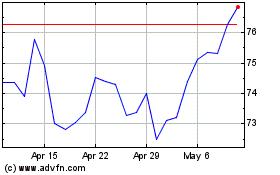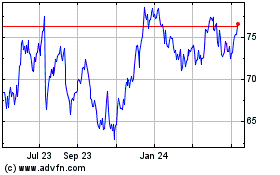State Street CIO Sparks Culture Change Around Problem-Solving
March 28 2019 - 4:57PM
Dow Jones News
By Sara Castellanos
State Street Corp.'s chief information officer is shaking up how
the 227-year-old bank tests new ideas, an effort that has brought
new services such as a chatbot for investors and a blockchain-based
auditing system.
Antoine Shagoury, who joined State Street in 2015, spearheaded a
crash course for the bank's employees in design thinking, a
decade-old methodology that Silicon Valley firms and others use to
improve products or solve problems. He introduced a method of
getting an idea through vetting and eventually to deployment while
keeping business value in mind. He also placed more emphasis on
understanding specific business problems and building technology
solutions for them.
"We had to get people out of their day jobs and into a room in
which they could talk about what they've always wanted to do but
never thought they could," said Mr. Shagoury, who previously was
chief operating officer and CIO of London Stock Exchange Group PLC.
"Then, we had people who knew how to listen."
Boston-based State Street is a custodian bank that offers
investment services and asset management but not other services
like mortgages. Since Mr. Shagoury joined, it has launched a number
of early-stage products and services, such as an AI-based chatbot
that can answer basic investor and employee questions, software
robots that automate mundane tasks for employees and a
blockchain-based authentication and auditing system.
Mr. Shagoury's efforts come as the asset-management industry
struggles with clients committing less new money to investment
funds. State Street said in January that it would cut 1,500
employees, less than 4% of its staff, as it automates parts of its
operations, marking a more aggressive phase in its yearslong plan
to cut expenses and keep pace with industry changes.
"Change is constant," Mr. Shagoury said. "We're definitely in a
part of the financial-services market that's under the most
pressure to adapt, change and [technologically] transform."
As incumbents across industries increasingly see technology as a
driver of future business performance, many face challenges getting
emerging technologies out of the experimental phase and deployed
throughout the organization. The lack of a formal process of
getting an idea out of a small team and into production could be
one reason that average enterprise investment in emerging
technology has remained relatively stagnant over the past
decade.
The urgency to innovate is part of what's motivating CIOs to
take on culture change at their companies, said Graham Waller, vice
president and distinguished analyst at Gartner Inc.'s digital
business leadership research team. But innovating quickly is hard
for companies whose employees have been conditioned to expect
incremental change, he said. "The industrial-era mindset is around
being steady, predictable, let's not fail, let's be absolutely
certain of the outcome before we start," he said.
In order to innovate with emerging technologies, State Street
had to upend existing processes and ways of thinking, Mr. Shagoury
said. He encouraged his team to embrace concepts of
entrepreneurship to "breathe innovation back" into the
40,000-person company, he said.
The CIO oversaw the hiring of several hundred technologists
specializing in areas of data and analytics, cloud computing and
blockchain. He formed a client-experience team of more than 200
employees, responsible in part for understanding, in detail, the
needs of State Street's top clients.
Getting an idea from inception to deployment began with design
thinking, which focuses on teams collaborating across disciplines
and the idea of "restless reinvention," Mr. Shagoury said. Every
new product or service is built as a prototype. Teams have to
listen, learn and course-correct as needed, all while keeping the
customer experience front and center, he said.
Over 18 months beginning in January 2017, 1,000 employees --
including those from information technology, marketing and other
parts of the business -- were trained in the method. "It teaches
people to listen differently and how to be innovative," Mr.
Shagoury said. "No one says 'No.' It's almost like a support
group."
Design-thinking sessions taught employees how to focus on the
entire client experience, which sometimes gets lost in product
development.
The product ideas now go through a vetting phase where a product
team of about 200 people is responsible for assessing whether they
meet the needs of the business and add financial value.
Products created as a result of this culture change include
artificial-intelligence-based systems that can read legal documents
and warn the company when state regulation changes may affect
services.
"We learned how to be open internally to a new product idea,"
Mr. Shagoury said.
Write to Sara Castellanos at sara.castellanos@wsj.com
(END) Dow Jones Newswires
March 28, 2019 16:42 ET (20:42 GMT)
Copyright (c) 2019 Dow Jones & Company, Inc.
State Street (NYSE:STT)
Historical Stock Chart
From Jun 2024 to Jul 2024

State Street (NYSE:STT)
Historical Stock Chart
From Jul 2023 to Jul 2024
